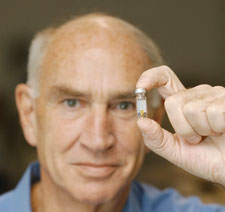Don Catlin, the certifier of Armstrong's cleanliness
 Melbourne/Adelaide - Don Catlin was the man who revealed the secrets of THG and darbepoetin, a variant of EPO. However, at age 70, he suddenly became popular in recent weeks as the man chosen by cycling hero Lance Armstrong to certify that he is clean.
Melbourne/Adelaide - Don Catlin was the man who revealed the secrets of THG and darbepoetin, a variant of EPO. However, at age 70, he suddenly became popular in recent weeks as the man chosen by cycling hero Lance Armstrong to certify that he is clean.
Three-and-a-half years after he retired - after winning his seventh consecutive Tour de France - the US cyclist, 37, returned to racing last week at the Tour Down Under.
Although he never tested positive, suspicions of doping always hovered over Armstrong's career. The obsessive sportsman hired Catlin's services to head a private antidoping programme that will, in his own words, subject Armstrong to an average of one test every three days.
The plan designed by the scientist, who is considered one of the main antidoping experts in the United States, was launched just before the start of the Tour Down Under, but there remain unanswered questions in relation to its content.
Catlin is set to test urine and blood samples that Armstrong takes, and he is set to publish the results on the Internet so they can be compared over time, which is in his opinion a better way to detect anomalies than isolated testing.
However, what data will he make public? Armstrong was reluctant to release his blood levels, something that Italy's Ivan Basso is set to do. Catlin insists on the T/E ratio
(testosterone/epitestosterone), but former cyclist Greg Lemond recently questioned its relevance.
In any case, Catlin has said he will freeze the samples for 2-5 years so they can be tested later.
And since Armstrong is a moving target, the scientist wants the tests to be carried out also in European laboratories. However, another problem springs up here.
The World Anti-Doping Agency (WADA) warns that its accredited centres can only accept and test samples issued by official organizations, because "individual" programmes do not test for all forbidden substances and methods on its list.
Catlin himself complained in an interview with the New York Daily News that there are too many agencies around, each with their own requirements.
Although it is Armstrong that is paying for the programme, the expert stresses he is independent.
Catlin headed for 25 years the laboratory at UCLA, the first in the United States to be recognized by WADA. There, he identified nearly a score of steroids and stimulants designed to avoid detection, although his greatest achievements were the discoveries of THG and darbepoetin.
Tetrahydrogestrinone (THG), known as "The Clear" at the Balco laboratory, put an end to the career of the star of the Sydney Olympics in 2000, US athlete Marion Jones, while darbepoetin cost the German-born Spaniard Johann Muehlegg his initial success at the 2002 Winter Olympics in Salt Lake City.
Two years ago, however, Catlin left the hunt and turned to research, founding Anti-Doping Research (ADR), a non-profit organization in Los Angeles that is open to athletes and institutions willing to "help rid sport of the influence of performance-enhancing drugs."
The United States' Major League Baseball, National Football League and biotechnology firm Amgen are among the main contributors to ADR's finances, while even the US Anti-Doping Agency (USADA) helps fund Catlin's brand. dpa